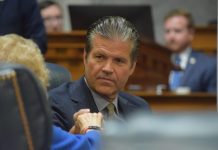“EPA’s mission is to protect human health and the environment. Congress intended the agency to collaborate with state and local governments to achieve this goal. Like other complex issues that our nation faces, environmental protection is a shared responsibility. We can only be successful by working together with our state and local partners,â€Â said EPA Office of Congressional and Intergovernmental Relations Associate Administrator Joe Brazauskas.
After 50 years of environmental protection, EPA understands that making progress requires strong cooperation and coordination between Washington, D.C., and the states. Much progress has been made over the past three years to restore the balance of responsibility shared between the federal government and states, which together have a robust network of regulations that protect our waterways and improve our air quality.
The first EPA Administrator, the late William Ruckelshaus, established EPA regional offices to empower states and local governments to implement the agency’s major authorizing statutes, including the Clean Air Act, the Clean Water and Safe Drinking Water Acts, and the Resource Conservation and Recovery Act.
States are now responsible for implementing over 96% of authorities available under federal environmental law. The result of our 50-year partnership is a clear and unambiguous success:
- From 1970 to 2019, U.S. criteria air pollutants decreased by 77% thanks to federal, state and local efforts while the economy grew 285%.
- In the 1960s, more than 40% of our nation’s drinking water systems failed to meet even the most basic health standards. Today, thanks to EPA’s strong partnerships with states, tribes, water systems, and other stakeholders, over 92% of community water systems meet all health-based standards.
- Since 1988, EPA has contributed $45 billion to the Clean Water State Revolving Fund, which have provided more than $138 billion in financial assistance through 41,000 low-cost loans for wastewater and stormwater infrastructure projects. Similarly, since 1997, EPA has contributed $21 billion to the Drinking Water State Revolving Fund, which have provided more than $41 billion in financial assistance to over 15,000 drinking water projects across the country.
- Since EPA’s Brownfields Program began in 1995, it has provided nearly $1.6 billion in grants to assess and clean up contaminated properties and return blighted properties to productive reuse. These investments have leveraged more than $32.6 billion in cleanup and redevelopment and created more than 167,487 jobs. Today, EPA continues its effort to revitalize communities with a particular focus in supporting reinvestment in federally designated Opportunity Zones.
Under the Trump Administration, EPA has made significant progress on restoring Federal Implementation Plans (FIPs) to State Implementation Plans (SIPs) to establish a path forward for bringing non-attainment areas into attainment with federal air quality standards, reducing the SIP backlog, and approving new SIPs. Since 2017, the agency has approved over 1,200 new and backlogged SIPs and converted 30 FIPs to SIPs; the agency has re-designated 40 areas across the country from non-attainment to attainment of certain federal air quality standards. By 2022, working with state partners, EPA is on track to re-designate at least 65 of the 166 nonattainment areas that were identified for tracking as of October 2017.
One of the most significant milestones in the effort to rebalance the relationship between the federal government and the states in managing land and water resources is the EPA’s and the Army Corps of Engineers’ Navigable Waters Protection Rule. Signed in January of this year, the final rule ensures America’s water protections remain strong while giving states and tribes the flexibility and certainty they need to manage their waters in ways that best protect their natural resources and local economies. The rule provides certainty and predictability that will save Americans time and money while accelerating infrastructure projects and economic development.
As EPA celebrates its 50th Anniversary, the agency recognizes the value of its partnerships with states and local governments in fulfilling our mission to protect human health and the environment.




